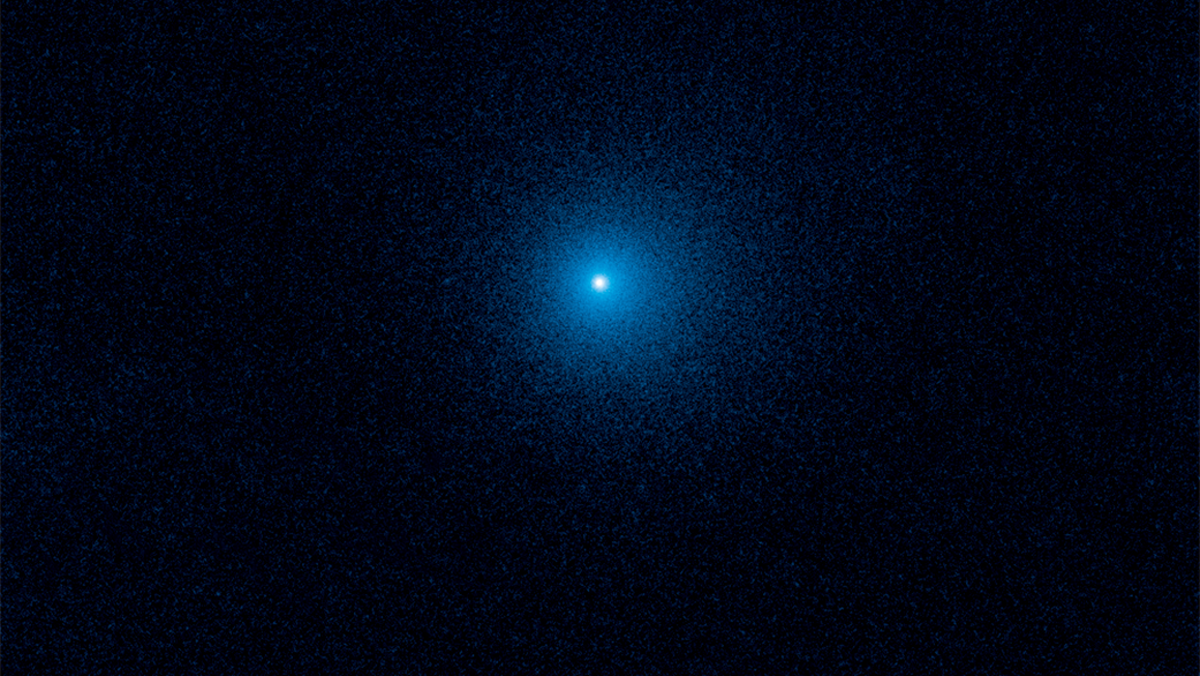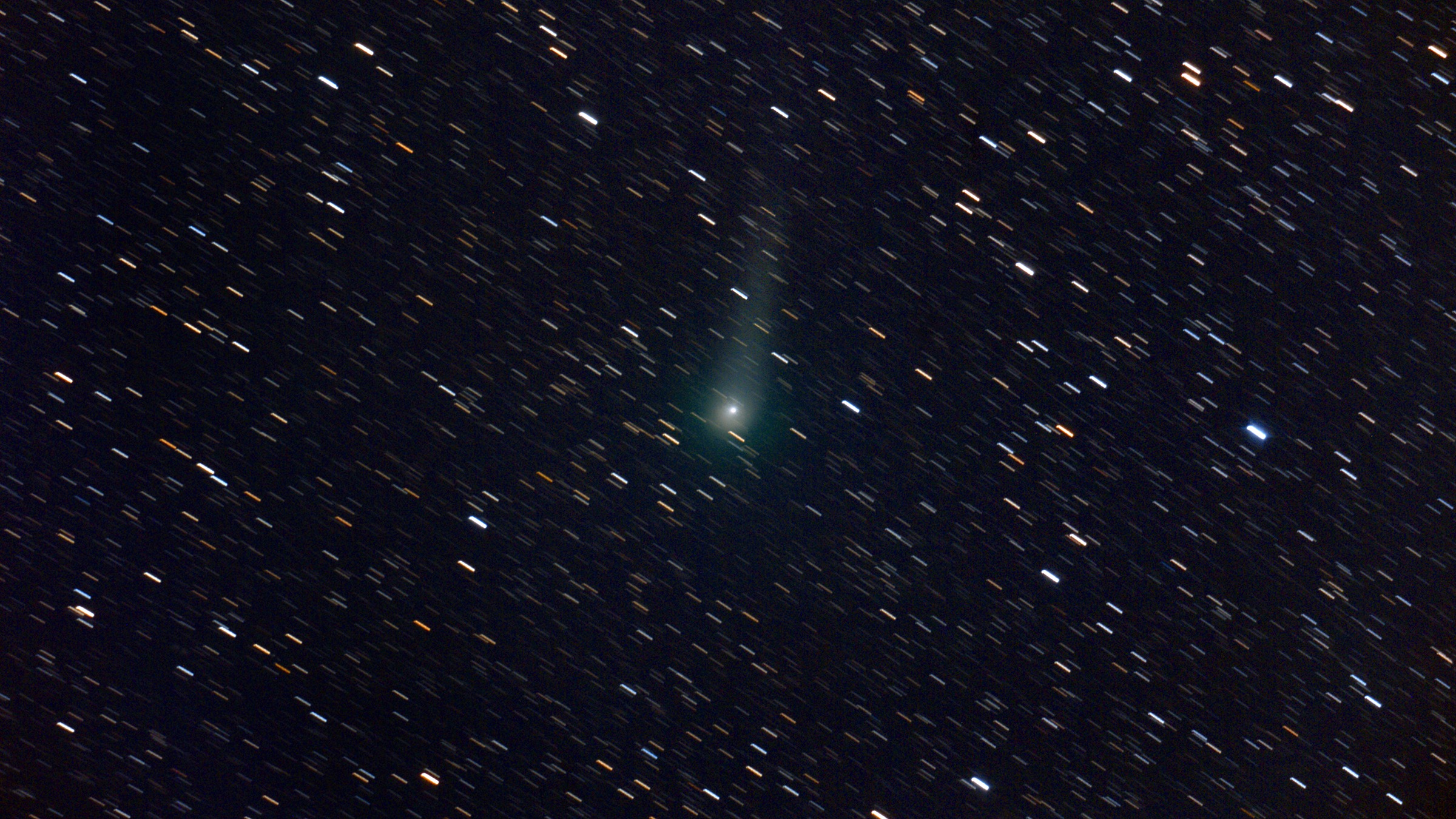The massive, strange Comet K2 is touring the solar system, surprising scientists as it goes
"It's kind of like being able to touch something from the beginning of the solar system."

Comet K2, one of the most distant 'active' comets ever discovered, is swinging past our planet this week as it makes its first ever journey from the outermost reaches of the solar system toward the sun. Astronomers are watching the mysterious ice ball in awe, making new and frequently surprising discoveries every step of the way.
"It's kind of like being able to touch something from the beginning of the solar system," David Jewitt, an astronomer at University of California, Los Angeles, told Space.com. "It's probably the most primitive thing in the inner solar system at this time."
Jewitt has published several papers on Comet K2 and was one of the first astronomers to study the object after it was discovered by the Panoramic Survey Telescope and Rapid Response System (PanSTARRS) in Hawaii in May 2017. At that time, the comet was about 17 times farther away from the sun than Earth is. Scientists call Earth's average distance from the sun an astronomical unit; one AU measures about 93 million miles (150 million kilometers).
Even at that distance, out between the orbits of Saturn and Uranus, the comet was emitting what scientists call a coma: a fuzzy halo of gas that extended 80,000 miles (130,000 kilometers) into space. That coma forms when frozen material on the comet sublimates, or transitions from a solid directly to a gas.
"As [comets] come in closer to the sun, they get warmer and warmer," Jewitt said. "And then the water ice is able to sublimate and create a rushing atmosphere of gas that makes the coma and the tail of the comet."
Related: Why is Comet K2 so hard to see given its huge size?
The halo that shouldn't be
It was this halo that surprised the astronomers. This deep in the solar system, the sun's rays are too feeble to cause any of the comet's frozen material to sublimate. Typically, that process only begins around Jupiter's orbit, at five AU.
Breaking space news, the latest updates on rocket launches, skywatching events and more!
Astronomers' surprise only grew when they found this halo in images taken even before the official discovery, when the comet was 23 AU from the sun, beyond the orbit of the solar system's outermost planet, Neptune.
Then, Jewitt determined that K2 must have already been active for several years when that first image was taken. Backward modelling showed that the comet must then have been oozing gas some 35 AU from the sun, deep within the Kuiper Belt, the disk of debris, space rocks and comets beyond the orbit of Neptune.
"At 35 AU from the sun, temperature is probably something like 40 degrees above absolute zero," Jewitt said. (Absolute zero corresponds to minus 460 degrees Fahrenheit, or minus 273 degrees Celsius. At this temperature, the natural movement of atoms stops). "So we know that water is as solid as rock there. It couldn't be responsible for the activity that we saw at those large distances."

A source of surprises
Ever since, Comet K2 has been a source of fascinating discoveries, surprising scientists with unexpected behaviors. But Jewitt thinks that what astronomers see K2 doing is not unique at all. Rather, the comet's behavior is probably typical for comets making their first trip toward the sun — we just haven't been able to observe it before.
"What makes this comet special is that it was discovered early," Jewitt said. "We've been able to follow the way the comet changes with distance from the sun over a much larger range than has ever been done before."
Comet K2 comes from even farther away than the Kuiper Belt, Jewitt said. The comet's original home was most likely the Oort cloud, the repository of comets and planetary fragments that extends from 2,000 to 200,000 AU from the sun. There, surrounded by billions of other frozen snowballs and space rocks, K2 spent billions of years slumbering until it received an unexpected gravitational kick, probably from a star passing by the outer edges of the solar system. This kick propelled K2 on the voyage that we can now observe in real time.
Pristine or not
It's the fact that the comet is on its debut trip through the solar system that makes it so scientifically valuable. With so little exposure to heat in its past, K2 should carry locked inside it chemicals that long since faded from more typical comets.
"Temperatures in the Oort cloud are really just a few degrees above absolute zero," Jewitt said. "Any material that was put into the nucleus of the comet when it formed has been frozen solid ever since. So the idea is that we are studying a little piece of the protoplanetary disk from the beginning of the solar system, which has been completely unchanged."
Comets are frequently considered to be time capsules carrying messages from the earliest days of the solar system formation. What astronomers are witnessing on K2, however, suggests that their chemistry may have changed much more than previously expected, as the ice balls made their journeys to the sun.
"If the activity begins really as far away from the sun as we see with this comet, then what we are seeing in other comets closer to the sun is not necessarily that pristine," Jewitt said. "Comet K2 helps us understand how primordial or pristine are the comets that we can observe in the inner solar system."
Carbon monoxide
From the earliest observations, Jewitt wanted to explain what makes up K2's mesmerizing coma. Since it couldn't be water ice that was sublimating from the surface, he and his colleagues knew there must be other chemical compounds turning into gas at such low temperatures.
"The one that we picked on first of all was carbon monoxide," Jewitt said. "Carbon monoxide has been detected in other comets closer to the sun, although in much lower quantities than water. Carbon monoxide is very volatile and hard to freeze into a solid."
Jewitt and his colleagues theorized that as the comet slightly warmed while moving toward the planetary region of the solar system, the carbon monoxide ice near its surface turned into a gas that streamed into the vacuum of interplanetary space like constant wind. This wind stirred up dust particles from the comet's surface, creating the round puffball-like coma.
But it took several failed attempts to measure the chemical composition of the comet to confirm the theory, Jewitt said. The team finally succeeded last year when the comet reached the orbit of Jupiter, and the scientists finally spotted carbon monoxide in the heart of the comet.
Missing tail
As astronomers observed K2 make its way to the inner solar system, they expected it to brighten. They also waited for the coma to develop the trademark tail-like shape typical for comets passing Earth. But for years, nothing was changing with K2, prompting both questions and theories.
"Those comet tails are caused by the pressure of sunlight that pushes the dust particles [that come out of the comet] away from the sun," Jewitt said. "This comet didn't have one until fairly recently."
To Jewitt, that means that the dust being blown out of the comet by ice turning to gas must be larger than scientists expected. Much larger, in fact: About a million times more massive.
"We were able to estimate the size [of those particles] to be, like, a 10th of a millimeter (about as wide as a human hair) or bigger," Jewitt said. "But the expectation was that because the initial sublimation [of the gasses] is very weak, they couldn't possibly expel big particles. Like on a windy day, when you see dust stirred on the street, you don't see cars blown down the street because they are so heavy."
When K2 makes its closest approach to Earth on Wednesday (July 13), it will be an underwhelming skywatching target. Well beyond the orbit of Mars, the comet will barely be visible even with binoculars or backyard telescopes.
But professional astronomers like Jewitt will keep K2 at the crosshairs of their powerful machines as the comet continues moving toward its December perihelion, when it is closest to the sun. They will try to extract as much science as possible, watching whether it undergoes the expected transformation, and then following it as it heads back into the Oort Cloud.
Jewitt thinks the James Webb Space Telescope, the first images of which were unveiled to the public on Tuesday (July 12), could shed more light on the mysterious comet K2. The telescope's powerful spectrometers could reveal the chemical composition of the comet in a much greater detail, including that of its oddly behaving dust.
"If we get the infrared spectrum with Webb, then we'll be able to figure out exactly what is in this coma. What type of dust do we see there?" Jewitt said.
Follow Tereza Pultarova on Twitter @TerezaPultarova. Follow us on Twitter @Spacedotcom and on Facebook.
Join our Space Forums to keep talking space on the latest missions, night sky and more! And if you have a news tip, correction or comment, let us know at: community@space.com.

Tereza is a London-based science and technology journalist, aspiring fiction writer and amateur gymnast. Originally from Prague, the Czech Republic, she spent the first seven years of her career working as a reporter, script-writer and presenter for various TV programmes of the Czech Public Service Television. She later took a career break to pursue further education and added a Master's in Science from the International Space University, France, to her Bachelor's in Journalism and Master's in Cultural Anthropology from Prague's Charles University. She worked as a reporter at the Engineering and Technology magazine, freelanced for a range of publications including Live Science, Space.com, Professional Engineering, Via Satellite and Space News and served as a maternity cover science editor at the European Space Agency.
